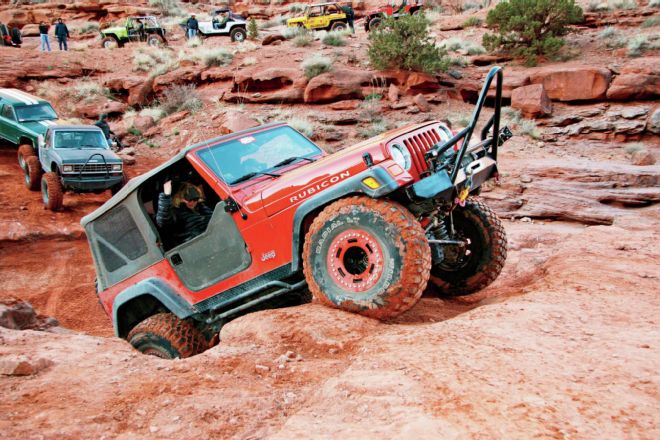
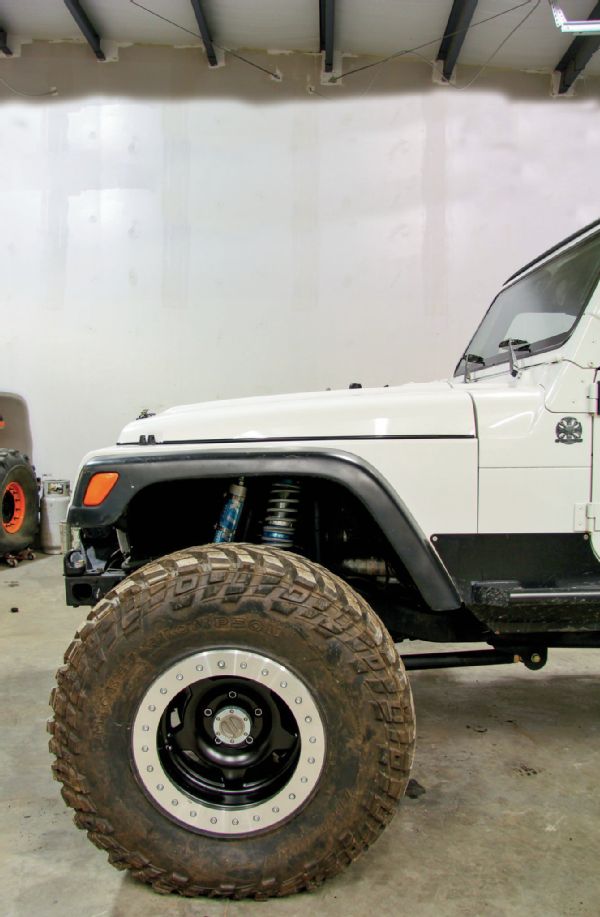 Ali Mansour
Brand Manager, 4WD & Sport Utility
Ali Mansour
Brand Manager, 4WD & Sport Utility
We’ve preached for years that a low lift height is the key to keeping your ’97-’06 Wrangler stable on the trail. Years ago, fitting 35s on a TJ with no lift seemed almost absurd. These days, it’s becoming the norm. So, what’s changed? Instead of bolting on a lift kit to provide clearance for oversized rubber, people are moving towards modifying the TJ’s body. Specifically, they are doing what is commonly known as a highline fender conversion.
A highline conversion means you are essentially raising the fender location upwards. This can be done with aftermarket fender kits, such as the ones offered by Poison Spyder Customs, GenRight, TnT Customs, and American Expedition Vehicles, or you can modify your existing fender set for a low-buck DIY highline conversion. We’ve done both, and each has its ups and downs. The ultimate goal of moving the fenders up (typically around 31⁄2 inches) is to provide clearance for larger tires.
In most cases, a conventional highline conversion will allot room for 35-inch tall tires, with no suspension or body lift needed. For those willing to be even more creative with their body modifications, it’s possible to run up to a 40-inch-tall tire with no suspension lift. Before you go cutting away at your stock sheetmetal, there are a few things you should know.
In this article, we are uncovering some of the things to prepare for and what will need to be modified with a typical highline conversion.

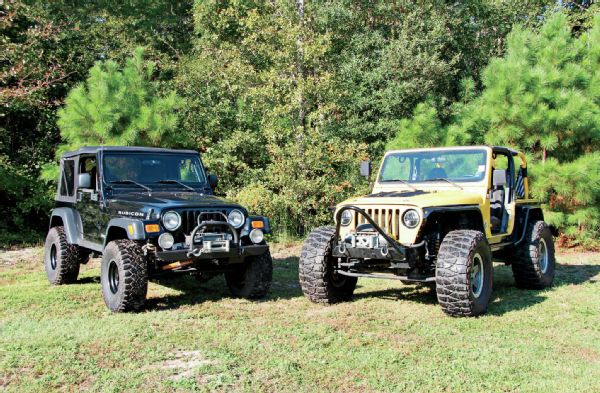 The TJ on the left is equipped with stock fenders, a 3.5-inch suspension lift, and 33-inch-tall tires. The TJ on the right is fit with a highline conversion, 3.5-inch suspension lift, and 37-inch tall tires. Both are similar in overall height, but the yellow one with the highline offers greater ground clearance overall.
The TJ on the left is equipped with stock fenders, a 3.5-inch suspension lift, and 33-inch-tall tires. The TJ on the right is fit with a highline conversion, 3.5-inch suspension lift, and 37-inch tall tires. Both are similar in overall height, but the yellow one with the highline offers greater ground clearance overall.
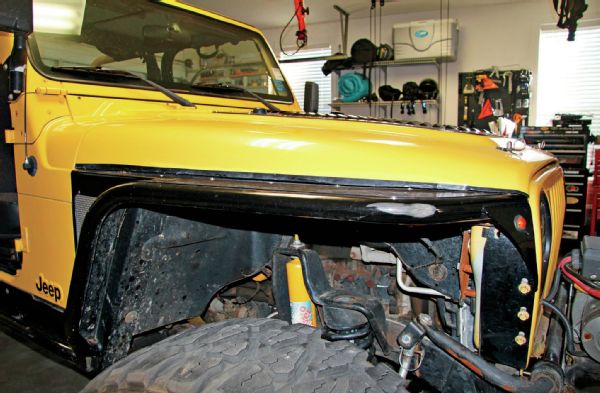 After you chop your hood, it will have a sharp edge at the bottom. There are a few ways to address this. If you are handy with sheetmetal, you can weld the original hood lip back to the hood for a factory-like finish. If you are looking for an easier route, we suggest painting the cut edge of the hood. Then, use door trim molding from your local parts store to line the bottom side of your hood. In our experience, the molding’s adhesive will eventually breakdown, and you will likely need to reapply a new piece of trim about once a year.
After you chop your hood, it will have a sharp edge at the bottom. There are a few ways to address this. If you are handy with sheetmetal, you can weld the original hood lip back to the hood for a factory-like finish. If you are looking for an easier route, we suggest painting the cut edge of the hood. Then, use door trim molding from your local parts store to line the bottom side of your hood. In our experience, the molding’s adhesive will eventually breakdown, and you will likely need to reapply a new piece of trim about once a year.
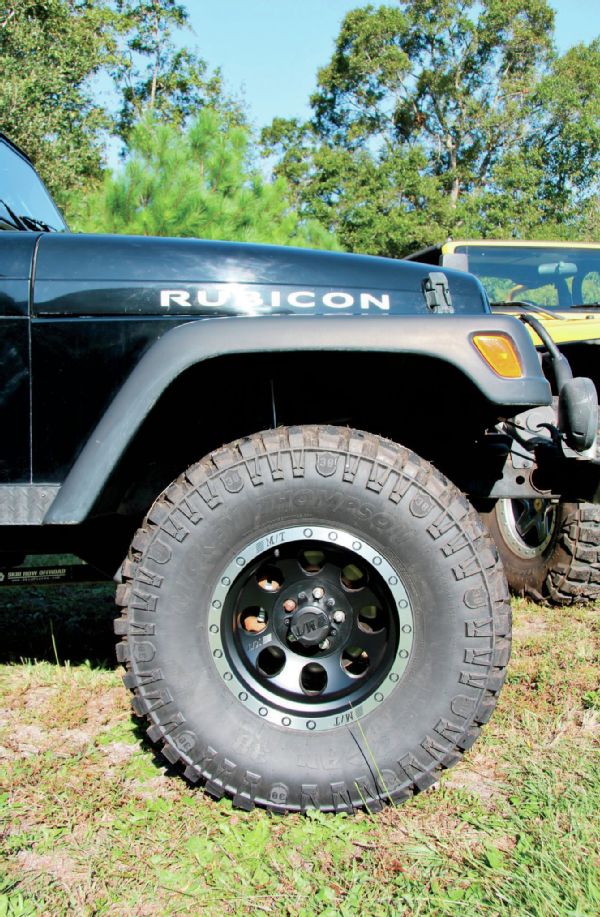 In this side-by-side photo, you can see that the yellow TJ fenders are raised roughly 31⁄2 inches over stock. This creates more room in the fenderwell for the 37s to easily cycle. With 37s on the other TJ, there wouldn’t be any clearance for the tire.
In this side-by-side photo, you can see that the yellow TJ fenders are raised roughly 31⁄2 inches over stock. This creates more room in the fenderwell for the 37s to easily cycle. With 37s on the other TJ, there wouldn’t be any clearance for the tire.
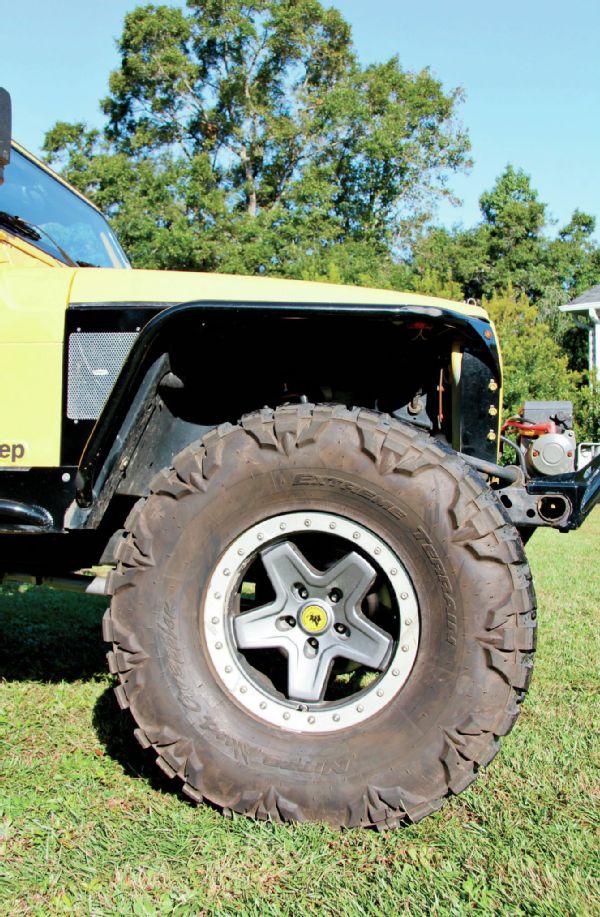 In this side-by-side photo, you can see that the yellow TJ fenders are raised roughly 31⁄2 inches over stock. This creates more room in the fenderwell for the 37s to easily cycle. With 37s on the other TJ, there wouldn’t be any clearance for the tire.
In this side-by-side photo, you can see that the yellow TJ fenders are raised roughly 31⁄2 inches over stock. This creates more room in the fenderwell for the 37s to easily cycle. With 37s on the other TJ, there wouldn’t be any clearance for the tire.
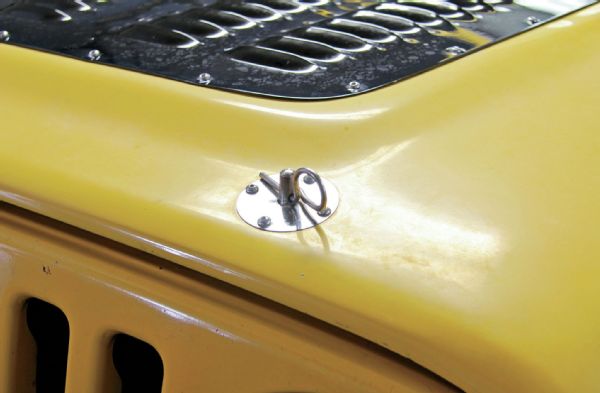 Depending on if you go with a kit or the homemade method, you will likely need to install hood pins. You can pick these up from your local parts store or many online retailers. The TJ’s grille and hood are very accommodating for hood pins, so overall, this will be an easy install.
Depending on if you go with a kit or the homemade method, you will likely need to install hood pins. You can pick these up from your local parts store or many online retailers. The TJ’s grille and hood are very accommodating for hood pins, so overall, this will be an easy install.
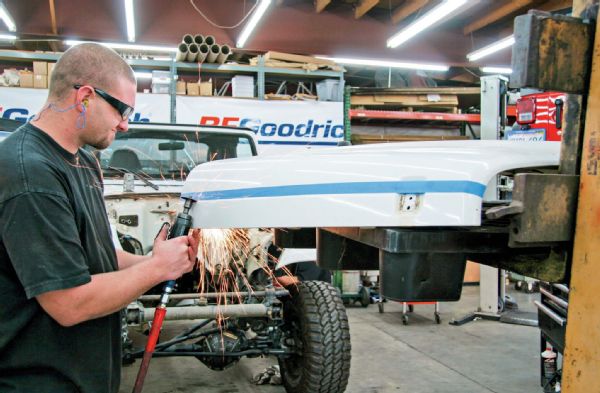 Since you are raising the front fender location with a highline conversion, the hood will need to be trimmed. We’ve found removing the hood completely and using a cutoff wheel to be the easiest technique. We’ve done a few highline conversions, and each Wrangler’s hood needed to be cut at slightly different heights, but around 31⁄2 inches is the norm. Start low and trim as needed. If this is something that you simply don’t see yourself doing, you can purchase a pre-cut performance hood from AEV.
Since you are raising the front fender location with a highline conversion, the hood will need to be trimmed. We’ve found removing the hood completely and using a cutoff wheel to be the easiest technique. We’ve done a few highline conversions, and each Wrangler’s hood needed to be cut at slightly different heights, but around 31⁄2 inches is the norm. Start low and trim as needed. If this is something that you simply don’t see yourself doing, you can purchase a pre-cut performance hood from AEV.
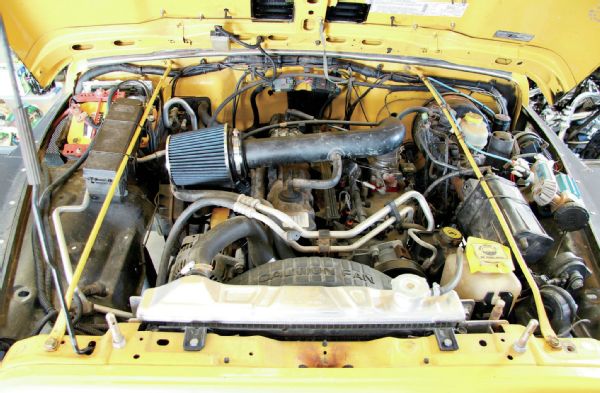 You’ll be surprised to find how much stuff actually mounts to your inner fenderwells and what kind of headache losing a few inches of room can create. Items such as your stock air intake, battery, fuse box, windshield wiper fluid reservoir, and emissions equipment will all need to be modified and/or find a new home. In the case of our buddy’s TJ, he ditched the stock intake for a modified cold-air intake, deleted the wiper reservoir, and got very creative with zip ties for the fuse box and emissions equipment.
You’ll be surprised to find how much stuff actually mounts to your inner fenderwells and what kind of headache losing a few inches of room can create. Items such as your stock air intake, battery, fuse box, windshield wiper fluid reservoir, and emissions equipment will all need to be modified and/or find a new home. In the case of our buddy’s TJ, he ditched the stock intake for a modified cold-air intake, deleted the wiper reservoir, and got very creative with zip ties for the fuse box and emissions equipment.
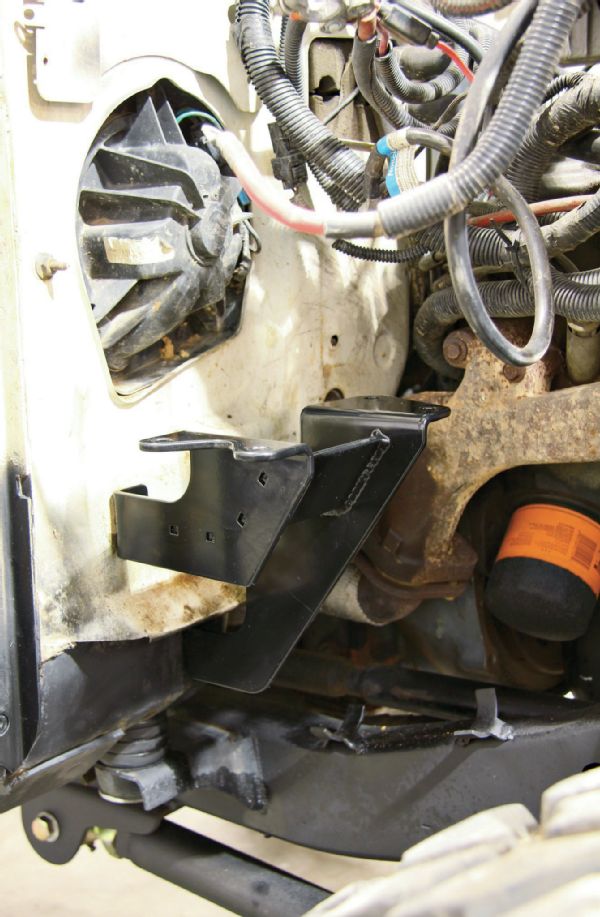 We mentioned battery relocation. This one is actually pretty easy. Companies like Poison Spyder Customs (bracket shown here) and GenRight both offer bolt-in battery trays that are designed to move the battery up and allow it to remain under the hood. Some of the trays will put the battery at angle, which could be an issue for a conventional battery due to size, performance, and potential water leaking issue. Be sure to budget for a dry-cell battery, such as the ones offered from Odyssey or Optima, as they can be had in various sizes and are engineered to operate at any angle.
We mentioned battery relocation. This one is actually pretty easy. Companies like Poison Spyder Customs (bracket shown here) and GenRight both offer bolt-in battery trays that are designed to move the battery up and allow it to remain under the hood. Some of the trays will put the battery at angle, which could be an issue for a conventional battery due to size, performance, and potential water leaking issue. Be sure to budget for a dry-cell battery, such as the ones offered from Odyssey or Optima, as they can be had in various sizes and are engineered to operate at any angle.
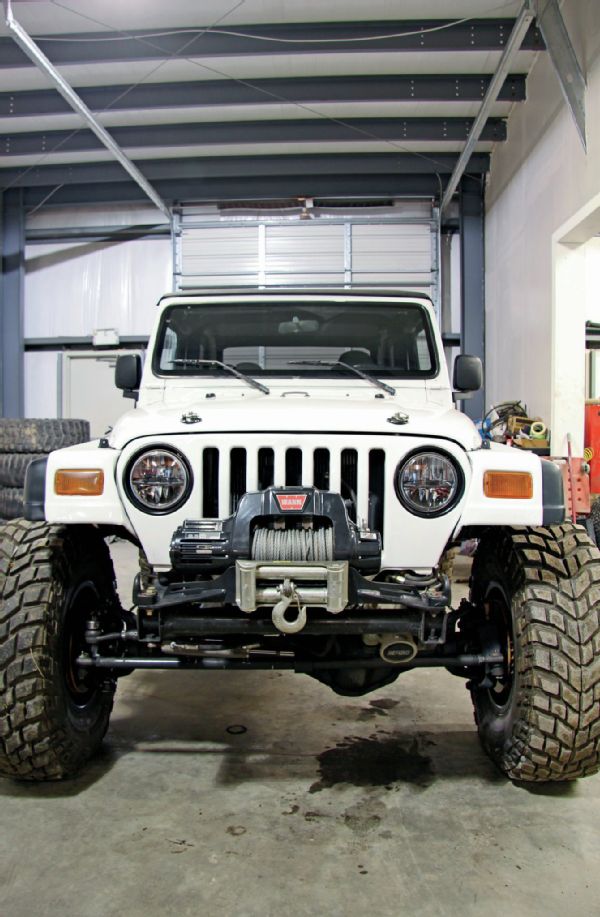 Since the TJ’s grille gets wider towards the top, the stock fender arch will not be the same when you move the fenders up a few inches. For those looking to achieve that stock-look with a highline conversion, it will be more involved process. The conversion shown here is a DIY with factory fenders. A more expensive, but newer and nicer way to go would be to opt for the AEV highline kit. The AEV kit actually provides you with factory-quality stamped-steel highline fenders that bolt in place of your stock units.
Since the TJ’s grille gets wider towards the top, the stock fender arch will not be the same when you move the fenders up a few inches. For those looking to achieve that stock-look with a highline conversion, it will be more involved process. The conversion shown here is a DIY with factory fenders. A more expensive, but newer and nicer way to go would be to opt for the AEV highline kit. The AEV kit actually provides you with factory-quality stamped-steel highline fenders that bolt in place of your stock units.
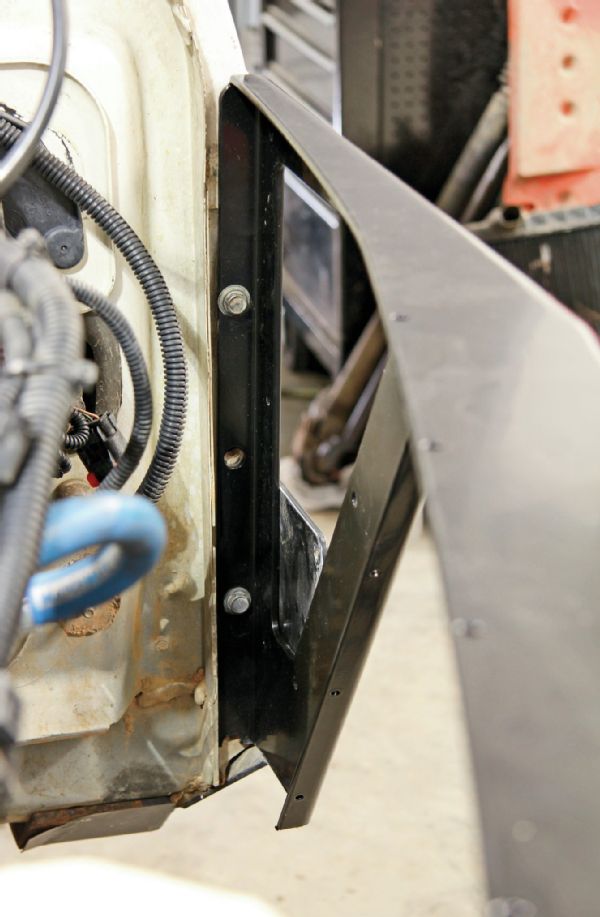 The TJ’s fenders bolt to the front of the TJ’s tub, which makes removal extremely easy. The flat surface also makes moving your stock fenders up pretty easy, as you will only need to drill a handful of holes.
The TJ’s fenders bolt to the front of the TJ’s tub, which makes removal extremely easy. The flat surface also makes moving your stock fenders up pretty easy, as you will only need to drill a handful of holes.
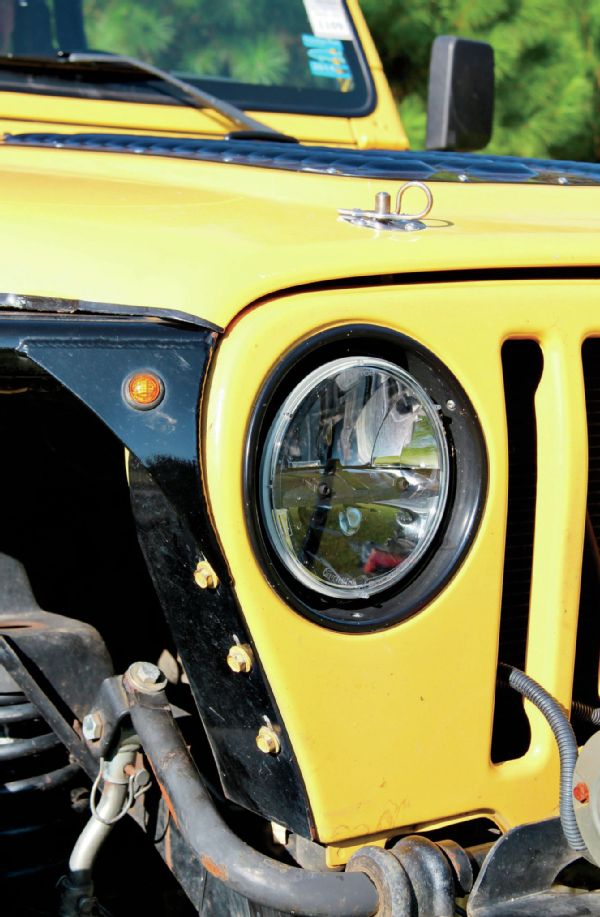 Of course, aftermarket highline fenders are designed to match the sweep of the TJ’s grill. If you already have an aftermarket flatfender, there is a good chance that you can make it work by modifying the metal strip that attaches the fender to the grill.
Of course, aftermarket highline fenders are designed to match the sweep of the TJ’s grill. If you already have an aftermarket flatfender, there is a good chance that you can make it work by modifying the metal strip that attaches the fender to the grill.
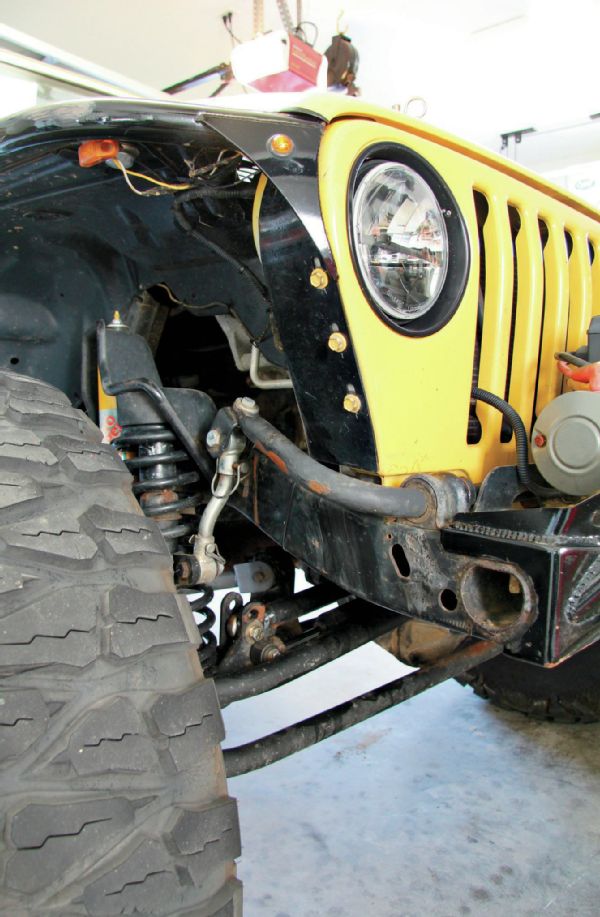 One issue we’ve run into when running 0-3 inches of lift and 35-inch-or-larger tires is that the front tires will make contact with the front sway bar more frequently. Adding wheel spacers can sometimes help, but it isn’t the best solution. If it’s a trail rig, we don’t mind ditching the bar altogether—after all, you are low and stable! For street-driven rigs, just know that the bar will run tire interference from time to time.
One issue we’ve run into when running 0-3 inches of lift and 35-inch-or-larger tires is that the front tires will make contact with the front sway bar more frequently. Adding wheel spacers can sometimes help, but it isn’t the best solution. If it’s a trail rig, we don’t mind ditching the bar altogether—after all, you are low and stable! For street-driven rigs, just know that the bar will run tire interference from time to time.
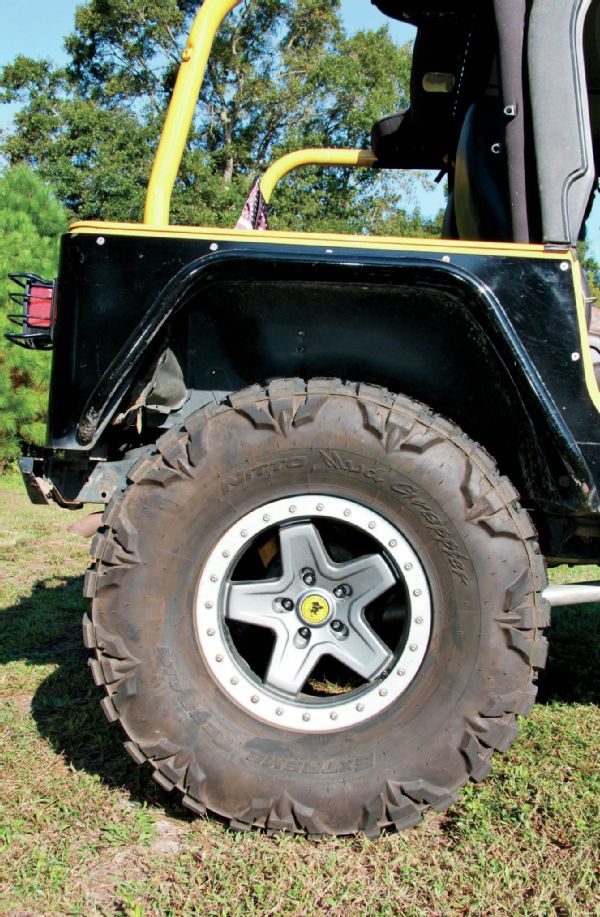 While the front of the Jeep needs more room for the tires to roam, the rear will need to be trimmed as well. The amount you’ll need to trim will vary depending on tire size. If you’ve trimmed all you can and you still rub (a common issue with 37s and no lift), you’ll need to incorporate a lower bumpstop or modify the existing mount to control the wheel travel. Aftermarket highline rear fenders, such as this GenRight set shown here, can also be added on as well.
While the front of the Jeep needs more room for the tires to roam, the rear will need to be trimmed as well. The amount you’ll need to trim will vary depending on tire size. If you’ve trimmed all you can and you still rub (a common issue with 37s and no lift), you’ll need to incorporate a lower bumpstop or modify the existing mount to control the wheel travel. Aftermarket highline rear fenders, such as this GenRight set shown here, can also be added on as well.
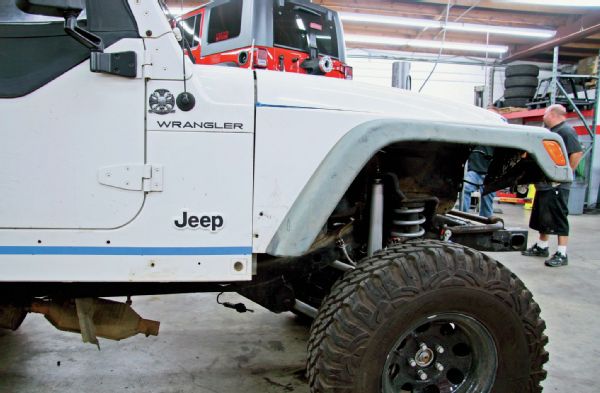 Moving your stock fenders up means you’ll have a gap at the bottom of your rockers. Fortunately, most body-mounted plate-steel rocker guards will cover this gap. Aftermarket fenders are designed to compensate for this length change and go the full length.
Moving your stock fenders up means you’ll have a gap at the bottom of your rockers. Fortunately, most body-mounted plate-steel rocker guards will cover this gap. Aftermarket fenders are designed to compensate for this length change and go the full length.
Hood-line
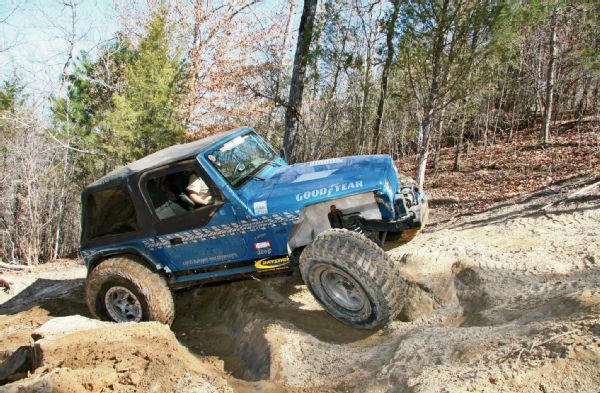
We couldn’t write a highline article in good conscience without mentioning Chris Durham Motorsports at least once. Why? Well, he’s made a name for himself as one of the top executors of functional low-lift, big tire TJs. His system isn’t exactly a fender conversion but more like a fender delete. With a Chris Durham Motorsport setup, you all but remove the front fenders and replace your stock hood with a lightweight fiberglass hood. This setup has allowed Chris to keep his Jeeps ultra-low. Out back, Durham even offers rear fiberglass flares to give your tire room to cycle, while offering a factory look.
Stock-line
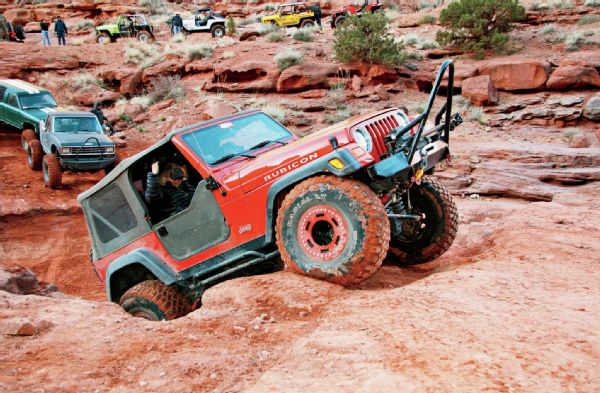
By now, you’ve likely figured out that a highline conversion has plenty of pros and cons. We feel it’s important to note that you can still have a completely stable and functional low-lift Jeep without hacking up your body panels. Running 31⁄2 inches of lift and 35s is extremely achievable with stock fenders, so long as you use bumpstops to moderate the suspension travel. The real challenge lies in running 37-inch and larger rubber, without trimming and moving body panels. Also, keep in mind that by modifying your Wrangler’s body but not the suspension, you don’t get any of the performance benefits (shock valving, heavy-duty control arms, flex joints, and so on) that are associated with a performance suspension system. You’ll likely spend the same amount of money modifying your body with an aftermarket highline conversion kit as you would a good suspension system. At the end of the day, we like a low center of gravity. You just have to figure out what works best for you and your budget.